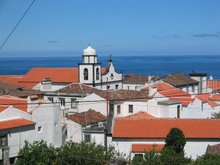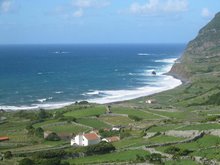This is the first of a series of blog entries on the history of Scotland I'm going to try and write without looking any of it up.
This first chapter is rather dull because it's an era I know particularly little about - prehistory. Later chapters (Braveheart and all that) will be more interesting, I promise. OK - here goes.
10,000 years ago, what is now Scotland was covered in glaciers as it was the last Ice Age - the bonnie heather clad banks of Loch What'sname looked like the South Pole on a bad day. When the ice had melted about 5,000 years later (give or take a few thousand years) Scotland was looking a bit like northern Siberia - still a bit parky but humans were beginning to move in. Probably the closest modern analogy to these people would be Inuit (Eskimos) a couple of hundred years ago before they came in contact with Europeans. That is to say hunter gatherers of seals, dolphins, fish and in summer, berries, roots etc. A nomadic people moving camp according to the seasons. This was the Stone Age, of course (Mesolithic).
I think I'm right in saying that the earliest traces of human settlement (using that word in its loosest sense because it was maybe just a nomadic seasonal camp) so far discovered in Scotland are on the island of Rum off the west coast. These are carbon dated to about 4,000BC. Although it might be 6,000BC - I can't remember now, he says bandying millennia around in a way that's going to sound a bit odd in contrast to when I later come on to say things like "it's important to understand that this happened in the morning of the 16 April 1746, not the afternoon."
The main tangible remains these people left to us are their rubbish: piles of seashells and animal and fish bones. These mesolithic landfill sites are called middens which is a good Scottish word meaning a rubbish dump. It's most often heard nowadays in expressions like "This room is a pure midden" meaning it's somewhat untidy. It also needs to be explained that "pure" is a peculiarly west of Scotland way of saying total, complete etc. Anyway, as I don't have a picture of one (and I expect they don't look that spectacular anyway), here's a picture of the island of Colonsay off the west coast of Scotland where mesolithic shell middens have been found.
This first chapter is rather dull because it's an era I know particularly little about - prehistory. Later chapters (Braveheart and all that) will be more interesting, I promise. OK - here goes.
10,000 years ago, what is now Scotland was covered in glaciers as it was the last Ice Age - the bonnie heather clad banks of Loch What'sname looked like the South Pole on a bad day. When the ice had melted about 5,000 years later (give or take a few thousand years) Scotland was looking a bit like northern Siberia - still a bit parky but humans were beginning to move in. Probably the closest modern analogy to these people would be Inuit (Eskimos) a couple of hundred years ago before they came in contact with Europeans. That is to say hunter gatherers of seals, dolphins, fish and in summer, berries, roots etc. A nomadic people moving camp according to the seasons. This was the Stone Age, of course (Mesolithic).
I think I'm right in saying that the earliest traces of human settlement (using that word in its loosest sense because it was maybe just a nomadic seasonal camp) so far discovered in Scotland are on the island of Rum off the west coast. These are carbon dated to about 4,000BC. Although it might be 6,000BC - I can't remember now, he says bandying millennia around in a way that's going to sound a bit odd in contrast to when I later come on to say things like "it's important to understand that this happened in the morning of the 16 April 1746, not the afternoon."
The main tangible remains these people left to us are their rubbish: piles of seashells and animal and fish bones. These mesolithic landfill sites are called middens which is a good Scottish word meaning a rubbish dump. It's most often heard nowadays in expressions like "This room is a pure midden" meaning it's somewhat untidy. It also needs to be explained that "pure" is a peculiarly west of Scotland way of saying total, complete etc. Anyway, as I don't have a picture of one (and I expect they don't look that spectacular anyway), here's a picture of the island of Colonsay off the west coast of Scotland where mesolithic shell middens have been found.
 Actually, it's Colonsay in the foreground with Oronsay across the water and Islay and Jura on the horizon. Total Celtic heartland.
Actually, it's Colonsay in the foreground with Oronsay across the water and Islay and Jura on the horizon. Total Celtic heartland.Well, as I said, that was a particularly dull introduction to Scottish history - mainly as it's not particularly Scottish and the same could be said about anywhere on the globe at the same lattitude.
Next time, I'll get on to something more distinctively Scottish like the standing stones of Callanish and the neolithic village at Skara Brae in Orkney. Also why Colonsay etc, as pictured above are not really Celtic at all but actually Scandinavian




3 comments:
Human settlement of the Azores didn't begin till the 15th century (assuming one disbelieves that it's the lost continent of Atlantis). I've read that during their first years on Flores, some of the island's earliest settlers lived in coastal caves south of Santa Cruz (between there and Lomba, I gather). Have you heard/read anything re this? If so, do you know whether archaeologists have studied the site(s)? Have you ever seen the caves?
Do you know whether scientists have also studied the how the last Ice Age affected the Azores' geology, flora and fauna, since the archipelago is at a significantly lower latitude than Scotland's?
Kathie - you're right. My understanding is also that the first settlement led by the Fleming Willem van der Haegen (aka in Portuguese Guilherme da Silveira) - dates unknown but last quarter of 15th cent. - lived in caves in the Ribeira da Cruz valley just south of Sta. Cruz. I have never seen the caves myself and I have no knowledge of any archaeological studies of them.
Azores way south of the last Ice Age, I would have thought. Certainly, no sign here of the glaciation effects on the terrain as we see in Scotland where I used to live. Can't speak for more indirect results like movement of flora /fauna etc.
No guarantees of either Wikipedia's or my accuracy ;-))) But here's a quick, slightly abridged, rough translation of the entry on Willem van der Hagen (prob. born ca. 1450-55), from http://pt.wikipedia.org/wiki/Willem_van_der_Hagen
Willem van der Hagen (later Guilherme da Silveira), was a Flemish nobleman who in 1470 landed on the island of Faial at the invitation of [the Fleming head honcho] Joss van Hurtere. Leading a second wave of settlers, van der Hagen brought with him his family and relatives, masters of a variety of trades. After feeling some ill-will and rivalry on Hurtere's part, he decided to leave the island. Hagen settled in Quatro Ribeiras, Terceira, establishing a wheat farm and the cultivation of the dye plant Isactis Tinctoria Lin. [woad?] (previously produced in Picardy and Normandy), which was exported to Flanders. In Lisbon he met Dona Maria de Vilhena, the widow of Dom Fernão Teles de Meneses, who ceded exploitation rights in exchange for payment of the rights to the islands of Floreiras - the name by which the islands of Flores and Corvo were then known.
By around 1478, Hagen had settled on Flores in Ribeira da Cruz. Owing to the isolation of the islands and difficulties in communication, the agricultural exploitation of the island was not successful given the difficulty in exportation. He then decided to leave the island, returning to Terceira, and from there went to the island of São Jorge where he settled permanently in Topo. He lived amid so much abundance that just 1/10th of the wheat fields he cultivated, according to Gaspar Frutuoso, yielded 50 to 60 moios [1 moio = 21,762 hectolitros] annually (Livro 6.º das Saudades da Terra). He died ca. 1500, and was buried in the ermida next to the Solar dos Tiagos in the village of Topo, today in ruins.
The Fleming Hage [sic] (meaning bosque) wound up translated into the Portuguese Silveira. A less euphonious rendering of his name is Guilherme Vanderaga.
Families in the Azores with the name Silveira, as a general rule, descend from the Fleming Willem van der Hagen. His descendants are scattered throughout all the islands of the Azores, although on Graciosa another branch of Silveiras arose descended from mainland Silveiras.
Post a Comment